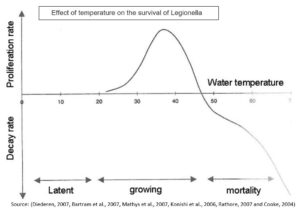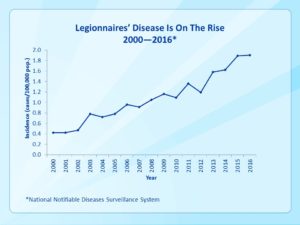History:
Legionella is a type of bacterium that was first identified in 1976 following an outbreak of pneumonia at a hotel in Philadelphia, Pennsylvania.
The bacterium was named after the American Legion convention that was being held at the hotel at the time of the outbreak, and was eventually identified as the cause of the illness. Since then, numerous outbreaks of Legionnaire’s disease (a severe form of pneumonia caused by Legionella) have been reported worldwide, primarily associated with water systems like hot tubs, air conditioning systems, and large plumbing systems.
In response, many countries have implemented regulations to prevent the spread of Legionella, including guidelines for the design, operation, and maintenance of building water systems.
These micro-organisms:
- are pathogenic, rod shaped gram-negative bacteria with size of about 1×2 microns
- are naturally present in most waters (endemic to most public water supplies)
- multiply easy in contained water areas with stagnant water between 32-40°C

- cannot sustain temperatures above 60°C
- are oxygen loving bacteria
- can cause inflammation of the lungs by inhalation
- are most commonly causing sickness by aspirating contaminated air and aerolized water droplets.
- can cause legionellosis (legionella pneumophila, often called legionnaires disease) or the non-fatal Pontic Fever.
- are a public health concern due to possible large outbreaks (ex. Philadelphia, July 1976)
Places of special concern:
- cooling towers (power plants and large air conditioning systems of buildings and ship’s)
- public shower installations (especially older installations and when not continuously in use)
- hospitals (especially vulnerable are transplant patients, people that need anesthesia and intubation)
- whirlpools, steam baths and hot-tubs
- specific buildings for expositions and tradeshows
- the bottom of tanks and water heaters (concentration of Mg and Ca scaling contributes to their presence)
Prevention of Legionella growth and spread can be achieved through several measures, including:
- Regular maintenance and cleaning of building water systems, including hot water tanks, cooling towers, and fountains.
- Proper water temperature control to prevent the growth of Legionella, with hot water being stored at a minimum of 60°C (140°F) and cold water at 20°C (68°F). This method takes time and energy and is not always possible or desired.
- Regular flushing of stagnant water from pipes, tanks, and other systems.
 Proper disinfection of water systems, using classic methods such as:
Proper disinfection of water systems, using classic methods such as:
- (shock) hyperchlorination (up to 50ppm) and flushing, which is time consuming and not environmentally friendly.
- continuous chlorination (3-4ppm), which merely suppresses L.pneumophila and is not beneficial for health.
- UV light treatment (at 254nm) which damages DNA and is not sufficient on its own. It has also no residual effect after treatment.
- ozone treatment.
- Installing and maintaining effective filtration systems to remove organic matter and biofilms that can support the growth of Legionella.
- Monitoring the water quality in building water systems, including regular testing for Legionella.
- Implementing effective management plans to address the risk of Legionella growth and spread, including regular risk assessments, training of building staff, and emergency response planning.
It is important to seek the advice of a water treatment specialist to ensure that appropriate measures are taken to prevent Legionella growth and spread in a building water system.
“Thus, PREVENTION IS KEY”
More modern and environmental friendly techniques are:
-Ultrasound for removal of biofilm and reduction of cfu’s
-Catalysts for removal of biofilm
-Copper (and silver) ionisation
-Other methods that contribute and also work on the biofilm like EM waves and the Bio-rings like Sialex,Merus and Wellan
Studies : ncbi-1-Research ncbi-2-Research
About the outbreak in Warstein, Germany
Recently in the news :
https://www.legionnairesdiseasenews.com/category/legionnaires-disease/
https://nieuws.vtm.be/buitenland/meer-mensen-besmet-met-veteranenziekte
Picture: deadly diseases and epidemics,
Jon Zonderman & Laurel Shader, M.D
infobase publishing 2006.
